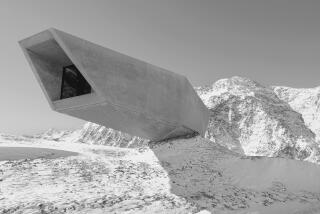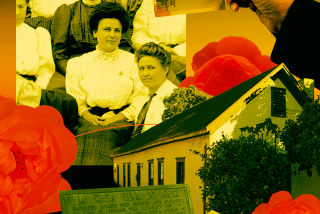SAN JUAN CAPISTRANO : Team Revives Age-Old Art of Making Adobe
- Share via
An art as old as the Mission San Juan Capistrano walls is being revived this week in this city’s historic downtown area.
It’s the art of making adobe, in this case using materials found in the back yard of the 19th-Century Avila Adobe on Camino Capistrano, just a block from the mission. Under the tutelage of Gil Sanchez of Santa Cruz, an architect who now specializes in adobe reconstruction, workers are mixing and drying pallets of adobe bricks that will be used to restore the 19th-Century home of Don Juan (El Rico) Avila.
Actually, this is not the prime time to mix adobe because the heat can dry the bricks too fast, Sanchez said. But he was making do.
“Usually we make the bricks in the spring, which allows them a longer time to cure,” Sanchez said. “We have had to spend two days testing our mixtures to see what works in this soil and sun.”
Adobe is made of four ingredients--dirt, sand, straw and water--the exact proportions of which depend on the sunshine and soil available, Sanchez said. The ingredients are not much different than those found in a red brick.
“Red bricks are just dirt too, except they are fired in a kiln,” Sanchez said. “Adobe is sun-dried.”
Sanchez and his workers do have at least one advantage over their ancient counterparts: the electric mixer.
“They used to dig a hole, pour in the ingredients and tamp the material down with their feet,” Sanchez said.
Sanchez and his team will spend the week making bricks and then will let them cure for at least 30 days before using them. The bricks, which are about 1 by 2 feet, have been designed to match those already found in the building.
The mortar used between adobe bricks and the plaster used to cover them also should be adobe and never cement, Sanchez said.
“Adobe bricks need to breathe,” he said. “If you cover them with plaster it traps the moisture inside and condensation occurs, which you don’t want. People often think by putting plaster over adobe they are saving it, but actually they’re making it worse.”
Thick adobe walls create a stable and well-insulated structure, said Robert Lawson, a structural engineer currently working as a consultant on the restabilization of Mission San Juan Capistrano.
“Because the bricks are very wide, they have a great deal of vertical load capacity,” Lawson said. “Because there is so much mass between the inside and outside of a building, the bricks are excellent for insulation. There is usually no problem maintaining an even temperature on the inside.”
The drawbacks of adobe brick is that it melts in rain and is not stable in earthquakes, Lawson said.
“If you use adobe anywhere where you have above 20 inches of rain a year, you’re asking for trouble,” he said. “Adobe is not recognized as an acceptable material in a seismic zone.”
To ensure the adobe’s stability, a concrete beam will be installed above the top layer of bricks that will tie into the roof, said Jim Bynum, the project’s contractor.


